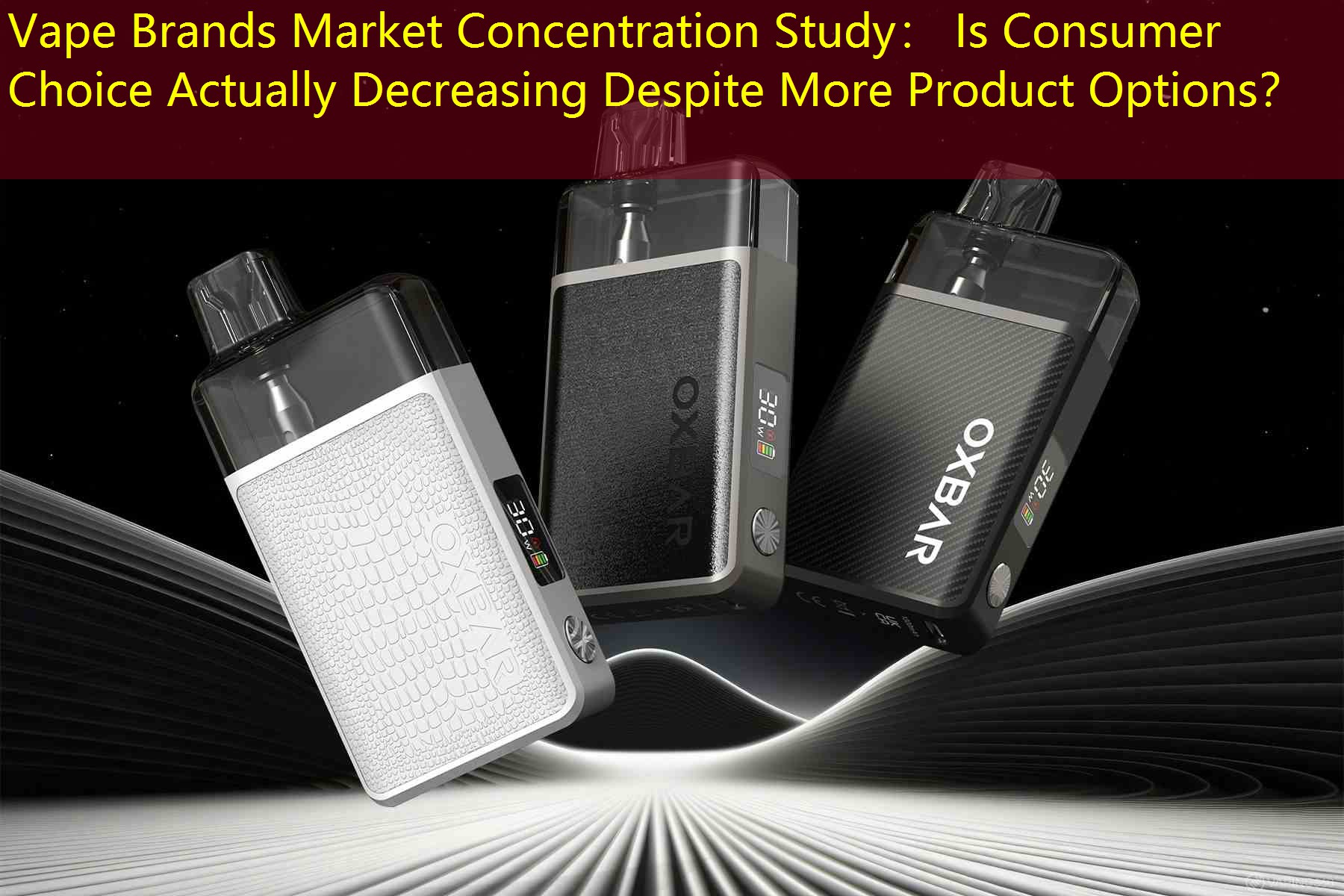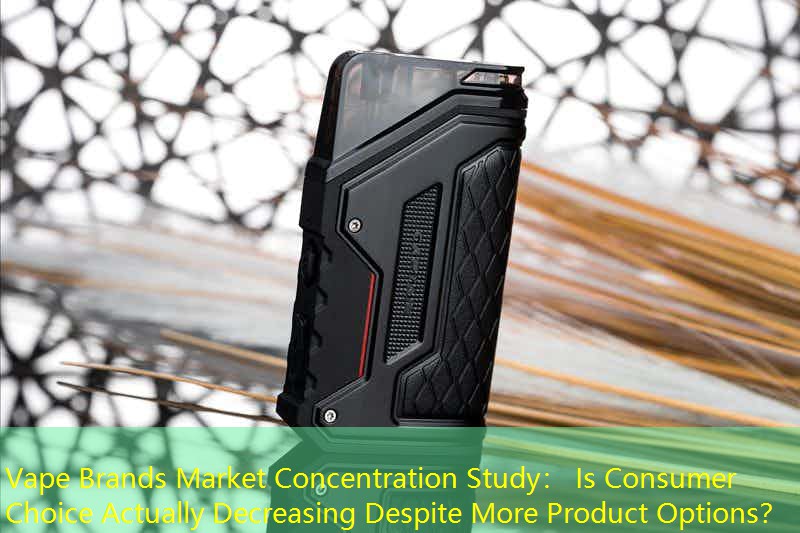வேப் பிராண்டுகள் சந்தை செறிவு ஆய்வு: அதிக தயாரிப்பு விருப்பங்கள் இருந்தபோதிலும், நுகர்வோர் தேர்வு உண்மையில் குறைகிறதா?
வேப்பிங் தொழில் தொடர்ந்து வளர்ந்து வருவதால், அதிக பிராண்டுகள் மற்றும் தயாரிப்புகள் சந்தையில் நுழைகின்றன, நுகர்வோர் தங்கள் விரல் நுனியில் ஏராளமான விருப்பங்களை வைத்திருப்பது போல் தெரிகிறது. இருப்பினும், நெருக்கமான ஆய்வு ஒரு சிக்கலான யதார்த்தத்தை வெளிப்படுத்துகிறது: வேப் தயாரிப்புகளின் எண்ணிக்கை நிச்சயமாக அதிகரித்துள்ளது, ஒரு சில முக்கிய பிராண்டுகளுக்கு இடையே உள்ள சக்தியின் செறிவு, நுகர்வோர் தேர்வு உண்மையாக விரிவடைகிறதா அல்லது சுருங்குகிறதா என்பது பற்றிய கவலையை எழுப்புகிறது. இந்தக் கட்டுரை vape பிராண்டுகளின் சந்தை இயக்கவியலை ஆராய்கிறது மற்றும் நுகர்வோருக்கு ஏற்படும் தாக்கங்கள் பற்றிய நுண்ணறிவுகளை வழங்குகிறது.

Understanding Market Concentration in the Vape Industry
Market concentration refers to the extent to which a small number of firms dominate total sales within an industry. In the vape industry, a few major players have established significant market shares, often overshadowing smaller brands. This concentration can lead to limited consumer choices, as major players tend to set trends and dictate supply.
While many new companies are emerging, the sheer influence of these dominant brands can result in a homogenization of product offerings. உதாரணமாக, brands like Juul and Vuse have become household names, largely due to their marketing strategies and widespread availability. This phenomenon raises a critical question: is the increase in product quantity matched by a similar increase in quality and diversity of consumer options?
The Illusion of Choice: A Closer Look
Even though the vape market boasts hundreds of products, the actual diversity in flavors, நிகோடின் அளவுகள், and device types may not be as vast as it appears. Many offerings from newer brands are often imitations of successful products from established companies. This leads to an environment where innovative or unique products struggle to gain traction.
Data from recent market analyses reveal that over 70% of vape sales are attributed to just a handful of brands. This concentration suggests that even with numerous products available, the real choices may be limited to a few popular selections. As such, consumers may find themselves stuck choosing between the same top players, effectively limiting their options despite the industry’s seemingly infinite variety.
Consumer Behavior and Brand Loyalty
Consumer preferences further complicate the concept of choice in the vape market. Many users develop a strong allegiance to specific brands due to their preferred flavors or the quality of experience provided. As consumers become accustomed to certain brands, their willingness to explore alternatives decreases, further entrenching the power of market leaders.
A survey conducted among vape users suggested that nearly 60% of respondents prefer a particular brand over others, not because of a broader assortment of options, but due to a lack of desire to navigate the overwhelming variety. This loyalty can create a cycle where consumers feel discouraged to explore new brands, falsely believing that sufficient options exist within their brand of choice.
Key Effect: Pricing and Accessibility
Price Sensitivity Among Consumers
Pricing dynamics also play a critical role in perceived consumer choice. Established vape brands often balance premium pricing strategies with widespread distribution, making their products accessible to a larger audience. இதற்கு மாறாக, smaller brands struggle to compete on price due to limited economies of scale.
A recent analysis comparing prices among top brands shows that the traditional players maintain competitive pricing, while niche markets often find themselves priced out, reducing choice. Consumers looking for unique flavors or innovative devices may have to pay a premium, which can deter exploration.
| பிராண்ட் | Average Price | Market Share |
|---|---|---|
| Juul | $19.99 | 33% |
| வூஸ் | $14.99 | 25% |
| Geek Bar | $12.99 | 15% |
| எல்ஃப் பார் | $13.99 | 10% |
| Other Brands | $11.99 | 17% |
Implications for Consumers
It is important to consider how market concentration affects consumer interests and industry accountability. A concentrated market can lead to mediocrity in product innovation and customer experience. மேலும், limited competition may result in fewer choices in flavor profiles, device styles, and safety innovations.
Understanding the balance between a wide array of options and the reality of brand dominance helps consumers navigate the vape landscape more effectively. They should critically evaluate their options, seeking out unique offerings that may not be as heavily marketed.
How Does Market Concentration Affect New Product Innovations?
Market concentration limits the entry of new players who provide innovative products, leading to a stagnation in consumer choices.
Are Smaller Brands Able to Compete Against Dominant Players?
While some smaller brands strive to carve out niches, they often struggle with visibility and marketing power, making competition challenging.

What Strategies Can Consumers Employ to Explore More Vape Options?
Consumers can seek community recommendations, reviews, and niche retailers to discover lesser-known vape brands and products that might meet their preferences.







